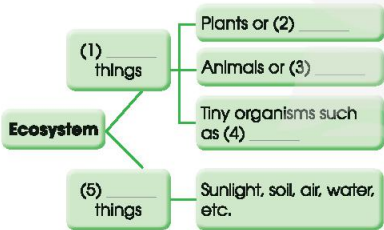Tiếng Anh 11 Unit 10 Getting Started1. Listen and read. 2. Read the conversation again and decide whether these statements are true (T) or false (F). 3. Complete the diagram with words in 1. 4. Use the words in the box to form compound nouns mentioned in 1. Match them with the meanings below. Tổng hợp đề thi học kì 2 lớp 11 tất cả các môn - Kết nối tri thức Toán - Văn - Anh - Lí - Hóa - Sinh
Lựa chọn câu để xem lời giải nhanh hơn
Bài 1 Video hướng dẫn giải Ecosystems and humans (Hệ sinh thái và con người) 1. Listen and read. (Nghe và đọc.) Ms Hoa: Nam, you went to Cuc Phuong National Park last weekend, didn‘t you? Nam: Yes, that’s right. It was an amazing trip. This old forest is home to thousands of different kind of plants, insects, and animals. I really liked the colourful butterflies and the thousand-year-old tree. Ms Hoa: Yes, Cuc Phuong National Park has a very rich ecosystem. Mai: What's an ecosystem, Ms Hoa? Ms Hoa: It's a community that has living things, like flora and fauna. Flora refers to plants and fauna refers to animals, including tiny organisms, like bacteria. Ecosystems also include non-living things, like sunlight, air, soil, and water. Nam: How important are ecosystems to life on our planet, Ms Hoa? Ms Hoa: Healthy ecosystems are essential for human health and survival because they provide us with goods such as food, energy, raw materials, clean water, and air. Mai: So we should protect our ecosystems, shouldn't we? Ms Hoa: That's right. Unfortunately, many ecosystems around the world are being lost, damaged, or destroyed because of climate change, pollution, and overuse of natural resources. It’s very important to protect and restore them for future generations. We don't want our planet to lose even more biodiversity, do we? Phương pháp giải: Tạm dịch: Cô Hoa: Nam, cuối tuần trước em đã đến Vườn quốc gia Cúc Phương phải không? Nam: Vâng, đúng ạ. Đó là một chuyến đi tuyệt vời. Khu rừng già này là nơi sinh sống của hàng nghìn loại thực vật, côn trùng và động vật khác nhau. Em thực sự thích những con bướm đầy màu sắc và cây cổ thụ hàng nghìn năm tuổi. Cô Hoa: Đúng vậy, vườn quốc gia Cúc Phương có hệ sinh thái rất phong phú. Mai: Hệ sinh thái là gì ạ, cô Hoa? Cô Hoa: Đó là một cộng đồng có các sinh vật sống, như hệ thực vật và động vật. Hệ thực vật đề cập đến thực vật và động vật đề cập đến động vật, bao gồm cả những sinh vật nhỏ bé, như vi khuẩn. Các hệ sinh thái cũng bao gồm những thứ không sống, như ánh sáng mặt trời, không khí, đất và nước. Nam: Hệ sinh thái quan trọng như thế nào đối với sự sống trên hành tinh của chúng ta, thưa cô Hoa? Cô Hoa: Các hệ sinh thái lành mạnh rất cần thiết cho sức khỏe và sự sống còn của con người vì chúng cung cấp cho chúng ta những hàng hóa như thực phẩm, năng lượng, nguyên liệu thô, nước sạch và không khí. Mai: Vậy chúng ta nên bảo vệ hệ sinh thái của chúng ta, phải không ạ? Cô Hoa: Đúng vậy. Thật không may, nhiều hệ sinh thái trên khắp thế giới đang bị mất, hư hại hoặc bị phá hủy do biến đổi khí hậu, ô nhiễm và sử dụng quá mức tài nguyên thiên nhiên. Điều rất quan trọng là bảo vệ và khôi phục chúng cho các thế hệ tương lai. Chúng ta không muốn hành tinh của mình mất đi sự đa dạng sinh học nhiều hơn, phải không? Bài 2 Video hướng dẫn giải 2. Read the conversation again and decide whether these statements are true (T) or false (F). (Đọc đoạn hội thoại một lần nữa và quyết định xem những câu này là đúng (T) hay sai (F).)
Lời giải chi tiết:
1. F Nam went to Cuc Phuong National Park two weeks ago. (Nam đã đến Vườn quốc gia Cúc Phương hai tuần trước.) Thông tin: Ms Hoa: Nam, you went to Cuc Phuong National Park last weekend, didn‘t you? (Nam, cuối tuần trước em đã đến Vườn quốc gia Cúc Phương phải không?) Nam: Yes, that’s right. (Vâng, đúng ạ.) 2. T In an ecosystem, plants, animals, and other living and non-living things form a community. (Trong một hệ sinh thái, thực vật, động vật và các sinh vật sống và không sống khác tạo thành một cộng đồng.) Thông tin: Mai: What's an ecosystem, Ms Hoa? (Hệ sinh thái là gì ạ, cô Hoa?) Ms Hoa: It's a community that has living things, like flora and fauna. Flora refers to plants and fauna refers to animals, including tiny organisms, like bacteria. Ecosystems also include non-living things, like sunlight, air, soil, and water. (Đó là một cộng đồng có các sinh vật sống, như hệ thực vật và động vật. Hệ thực vật đề cập đến thực vật và động vật đề cập đến động vật, bao gồm cả những sinh vật nhỏ bé, như vi khuẩn. Các hệ sinh thái cũng bao gồm những thứ không sống, như ánh sáng mặt trời, không khí, đất và nước.) 3. T We are losing a large number of ecosystems around the world. (Chúng ta đang mất đi một số lượng lớn các hệ sinh thái trên khắp thế giới.) Thông tin: Unfortunately, many ecosystems around the world are being lost, damaged, or destroyed because of climate change, pollution, and overuse of natural resources. (Thật không may, nhiều hệ sinh thái trên khắp thế giới đang bị mất, hư hại hoặc bị phá hủy do biến đổi khí hậu, ô nhiễm và sử dụng quá mức tài nguyên thiên nhiên.) Bài 3 Video hướng dẫn giải 3. Complete the diagram with words in 1. (Hoàn thành sơ đồ với các từ trong 1.)
Lời giải chi tiết:
Bài 4 Video hướng dẫn giải 4. Use the words in the box to form compound nouns mentioned in 1. Match them with the meanings below. (Sử dụng các từ trong hộp để tạo thành các danh từ ghép được đề cập trong phần 1. Nối chúng với các nghĩa bên dưới.)
Phương pháp giải: raw (adj): thô climate (n): khí hậu change (n): thay đổi resources (n): tài nguyên park (n): công viên natural (adj): thuộc về tự nhiên national (adj): thuộc về quốc gia materials (n): nguyên liệu/ vật chất Lời giải chi tiết:
1. a change in the earth's weather conditions = climate change (sự thay đổi điều kiện thời tiết của trái đất = biến đổi khí hậu) 2. things that exist in nature and can be used by people = natural resources (những thứ tồn tại trong tự nhiên và con người có thể sử dụng = tài nguyên thiên nhiên) 3. land protected by the government because of its natural beauty or special history = national park (vùng đất được chính phủ bảo vệ vì vẻ đẹp tự nhiên hoặc lịch sử đặc biệt = công viên quốc gia/ vườn quốc gia) 4. basic materials used to make products = raw materials (nguyên vật liệu cơ bản làm nên sản phẩm = nguyên liệu thô)
>> 2K9 Học trực tuyến - Định hướng luyện thi TN THPT, ĐGNL, ĐGTD ngay từ lớp 11 (Xem ngay) cùng thầy cô giáo giỏi trên Tuyensinh247.com. Bứt phá điểm 9,10 chỉ sau 3 tháng, tiếp cận sớm các kì thi.
|






















